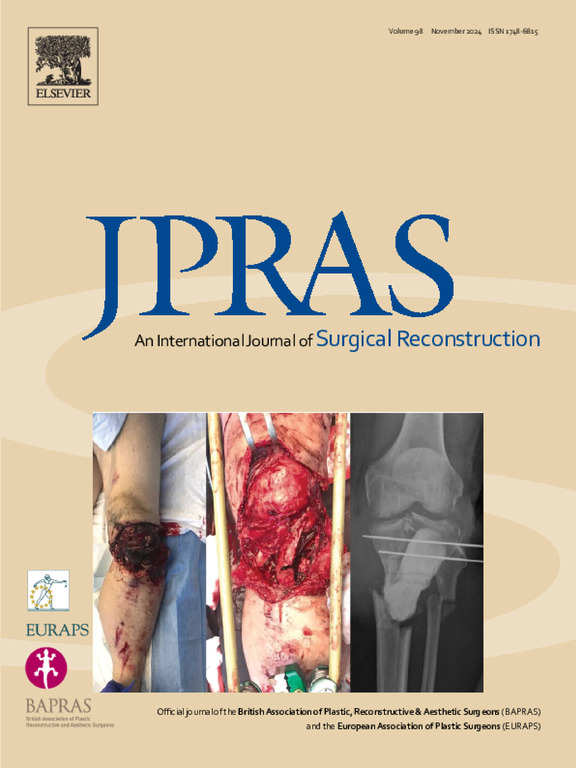Sensory restoration following breast reconstruction with operative reinnervation: A systematic review and meta-analysis
IF 2
3区 医学
Q2 SURGERY
Journal of Plastic Reconstructive and Aesthetic Surgery
Pub Date : 2025-03-01
DOI:10.1016/j.bjps.2024.10.021
引用次数: 0
Abstract
Background
There is currently no consensus on the efficacy of operative reinnervation at the time of post-mastectomy reconstruction. This review compares postoperative sensation between innervated and non-innervated flaps in breast reconstruction through systematic review and meta-analysis.
Methods
EMBASE, Ovid, and CENTRAL were searched from inception to December 6, 2023. The primary outcome was level of sensation postoperatively. Secondary outcomes included presence of sensation, breast-related complications, operative time, and quality of life. Meta-analysis was conducted using mean difference (MD) or standardized mean difference (SMD) for continuous outcomes and odds radio (OR) for dichotomous outcomes. Quality of evidence was appraised using RoB-2/ROBINS-I. Certainty of evidence was assessed with Grading of Recommendations, Assessment, Development and Evaluations.
Results
Twenty-eight studies were included; studies were observational studies except one randomized controlled trial. Common flaps were deep inferior epigastric perforator (11/28, 39.3%) and transversus rectus abdominis muscle (9/28, 32.1%). Innervated flaps were significantly associated with improved level of postoperative sensation (SMD: −0.94, 95% CI: [−1.35; −0.53], I2: 78%, p < 0.01), presence of postoperative sensation (OR: 11.4, 95% CI: [5.09; 24.5], I2: 0%, p < 0.01), and improved postoperative BREAST-Q scores (MD: 8.11, 95% CI: [4.33; 11.89], I2: 27%, p < 0.01). However, certainty of evidence was low/very low for all outcomes. Most studies had moderate risk of bias (56.5%). There were no statistically significant differences in breast-related complications or operative time.
Conclusions
Operative reinnervation in breast reconstruction is significantly associated with improved level and presence of postoperative sensation and BREAST-Q scores without significant increase in breast-related complications/operative time. More high-quality studies are required to improve the certainty of outcomes.
手术神经再支配乳房重建后的感觉恢复:系统回顾和荟萃分析。
背景:目前,关于乳房切除术后重建时手术神经再支配的疗效尚未达成共识。本综述通过系统综述和荟萃分析比较了乳房重建中神经支配瓣和非神经支配瓣的术后感觉:方法:检索了从开始到 2023 年 12 月 6 日的 EMBASE、Ovid 和 CENTRAL。主要结果是术后的感觉水平。次要结果包括是否有感觉、乳房相关并发症、手术时间和生活质量。对于连续性结果,采用平均差(MD)或标准化平均差(SMD)进行荟萃分析;对于二分性结果,采用几率收音机(OR)进行荟萃分析。证据质量采用 RoB-2/ROBINS-I 进行评估。证据的确定性采用建议、评估、发展和评价分级法进行评估:共纳入 28 项研究;除一项随机对照试验外,其余均为观察性研究。常见的皮瓣是下腹深穿孔肌皮瓣(11/28,39.3%)和腹直肌横肌皮瓣(9/28,32.1%)。有神经支配的皮瓣与术后感觉水平的改善明显相关(SMD:-0.94,95% CI:[-1.35; -0.53],I2:78%,P 2:0%,P 2:27%,P 结论:乳房再造术中的神经再支配与术后感觉水平和存在的改善以及 BREAST-Q 评分显著相关,而乳房相关并发症/手术时间不会明显增加。需要更多高质量的研究来提高结果的确定性。
本文章由计算机程序翻译,如有差异,请以英文原文为准。
求助全文
约1分钟内获得全文
求助全文
来源期刊
CiteScore
3.10
自引率
11.10%
发文量
578
审稿时长
3.5 months
期刊介绍:
JPRAS An International Journal of Surgical Reconstruction is one of the world''s leading international journals, covering all the reconstructive and aesthetic aspects of plastic surgery.
The journal presents the latest surgical procedures with audit and outcome studies of new and established techniques in plastic surgery including: cleft lip and palate and other heads and neck surgery, hand surgery, lower limb trauma, burns, skin cancer, breast surgery and aesthetic surgery.

 求助内容:
求助内容: 应助结果提醒方式:
应助结果提醒方式:


